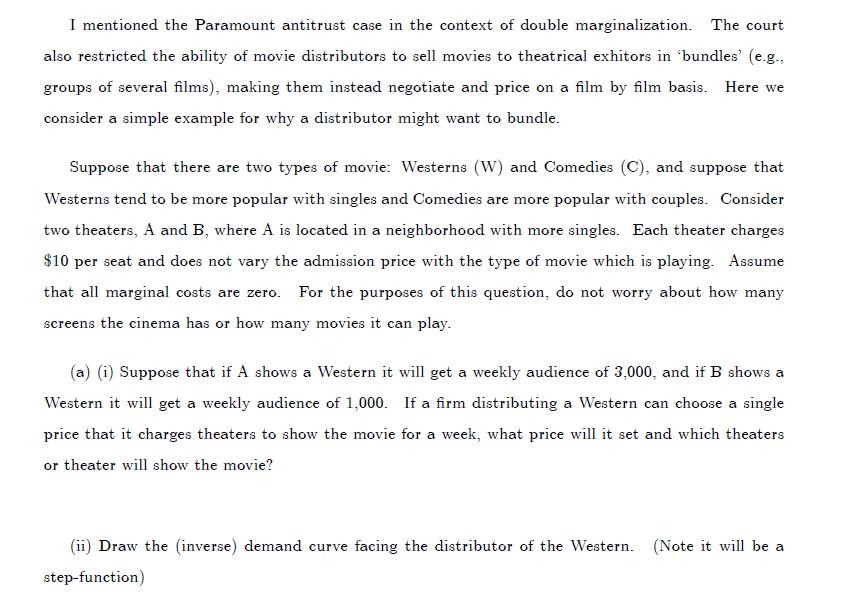Answered step by step
Verified Expert Solution
Question
1 Approved Answer
I mentioned the Paramount antitrust case in the context of double marginalization. The court also restricted the ability of movie distributors to sell movies



I mentioned the Paramount antitrust case in the context of double marginalization. The court also restricted the ability of movie distributors to sell movies to theatrical exhitors in 'bundles' (e.g., groups of several films), making them instead negotiate and price on a film by film basis. Here we consider a simple example for why a distributor might want to bundle. Suppose that there are two types of movie: Westerns (W) and Comedies (C), and suppose that Westerns tend to be more popular with singles and Comedies are more popular with couples. Consider two theaters, A and B, where A is located in a neighborhood with more singles. Each theater charges $10 per seat and does not vary the admission price with the type of movie which is playing. Assume that all marginal costs are zero. For the purposes of this question, do not worry about how many screens the cinema has or how many movies it can play. (a) (i) Suppose that if A shows a Western it will get a weekly audience of 3,000, and if B shows a Western it will get a weekly audience of 1,000. If a firm distributing a Western can choose a single price that it charges theaters to show the movie for a week, what price will it set and which theaters or theater will show the movie? (ii) Draw the (inverse) demand curve facing the distributor of the Western. (Note it will be a step-function) (b) Suppose that if B shows a Comedy it will get a weekly audience of 3,500, and if A shows a Comedy it will get a weekly audience of 2,000. If a firm distributing a Comedy can choose a single price that it charges theaters to show the movie, what price will it set and which theaters or theater will show the movie? (ii) Draw the (inverse) demand curve in this case. (c) Suppose that the same distributor is making both types of movie. Now suppose that it offers a bundle that includes both movies at a single price, and theaters have either to take both movies or take neither. Demands are as above. What price will it set for the bindle, and which theaters or theater will buy the bundle of movies? 5 (ii) Draw the inverse demand curve for the bundle. How does it compare to the inverse demand curves above?
Step by Step Solution
★★★★★
3.45 Rating (148 Votes )
There are 3 Steps involved in it
Step: 1
a i Maximum Price A is willing to pay for Western 10 3000 30000 Maximum Price ...
Get Instant Access to Expert-Tailored Solutions
See step-by-step solutions with expert insights and AI powered tools for academic success
Step: 2

Step: 3

Ace Your Homework with AI
Get the answers you need in no time with our AI-driven, step-by-step assistance
Get Started


